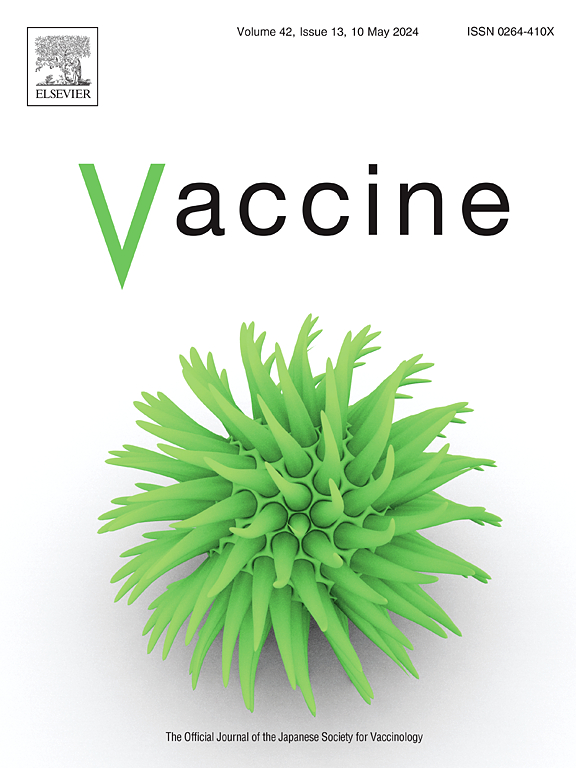美国老年人在COVID-19大流行之前和期间带状疱疹疫苗接种的变化
IF 4.5
3区 医学
Q2 IMMUNOLOGY
引用次数: 0
摘要
目的研究美国老年人在2019冠状病毒病大流行之前和期间的带状疱疹(HZ)疫苗接种率变化及其相关因素。方法利用全国健康访谈调查(National Health Interview Survey)数据,对年龄≥50岁的成年人在COVID-19大流行前(2018-2019年)和期间(2020 - 2022年)的HZ疫苗接种情况进行估计。我们使用对数二项回归来检查摄取随社会人口统计学和健康特征的调整和分层的变化。结果79786例成人(平均年龄66.4岁;男性:55.6%),摄取流行率从大流行前的25.1%上升到大流行期间的30.1%,流行率增加了1.36倍(调整流行比:1.36 [95% CI: 1.30-1.41])。在所有亚组中都观察到这种增加,在50-64岁的成年人、男性、非西班牙裔黑人和其他种族、低收入家庭、来自西部地区、与伴侣同住、目前吸烟者、以前接种过流感疫苗以及没有合并症的人群中,这种增加更为显著。尽管有所增加,但与其他亚组相比,这些亚组在大流行期间的摄入量仍然明显较低。结论尽管在COVID-19大流行期间,老年人的HZ疫苗接种率与大流行前相比有所增加,并且在少数民族、低收入、肥胖和吸烟人群中这种增加更为突出,但接种率仍然不理想。随着人口老龄化,需要持续监测和更好的战略,以确保吸收继续增加。本文章由计算机程序翻译,如有差异,请以英文原文为准。
Change in herpes zoster vaccination uptake before and during the COVID-19 pandemic in the United States older adults
Objectives
To examine changes in herpes zoster (HZ) vaccination uptake among older adults in the United States before and during the COVID-19 pandemic and related factors.
Methods
We estimated HZ vaccination uptake before (2018–2019) and during (2020−2022) the COVID-19 pandemic among adults aged ≥50 years using the National Health Interview Survey data. We used log-binomial regression to examine uptake changes with adjustment for and stratification by sociodemographic and health characteristics.
Results
Among 79,786 adults (mean age: 66.4 years; male: 55.6 %), the uptake prevalence increased from 25.1 % before the pandemic to 30.1 % during the pandemic, with a 1.36-fold increase in prevalence (adjusted prevalence ratio: 1.36 [95 % CI: 1.30–1.41]). Such increase was observed across all subgroups, with more prominent increases among adults aged 50–64 years, men, non-Hispanic Black and other ethnicity, those with low household income, from West regions, living with partners, current smokers, received prior flu vaccinations, and those without comorbidities. Despite these increases, the uptake during the pandemic remained significantly lower in these subgroups compared to others.
Conclusions
Although HZ vaccination uptake among older adults increased during the COVID-19 pandemic compared to before the pandemic, and this increase was more prominent among ethnic minorities, low-income, and obese and smoker groups, uptake remains suboptimal. With the ageing population, ongoing monitoring and better strategies are required to ensure uptake continues to increase.
求助全文
通过发布文献求助,成功后即可免费获取论文全文。
去求助
来源期刊

Vaccine
医学-免疫学
CiteScore
8.70
自引率
5.50%
发文量
992
审稿时长
131 days
期刊介绍:
Vaccine is unique in publishing the highest quality science across all disciplines relevant to the field of vaccinology - all original article submissions across basic and clinical research, vaccine manufacturing, history, public policy, behavioral science and ethics, social sciences, safety, and many other related areas are welcomed. The submission categories as given in the Guide for Authors indicate where we receive the most papers. Papers outside these major areas are also welcome and authors are encouraged to contact us with specific questions.
 求助内容:
求助内容: 应助结果提醒方式:
应助结果提醒方式:


